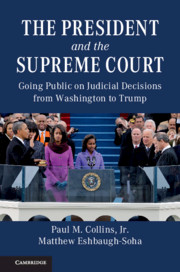Book contents
- The President and the Supreme Court: Going Public on Judicial Decisions from Washington to Trump
- The President and the Supreme Court: Going Public on Judicial Decisions from Washington to Trump
- Copyright page
- Dedication
- Contents
- Figures
- Tables
- Preface
- 1 Going Public and the Supreme Court
- 2 Going Public on Pending Decisions
- 3 Going Public on Decided Cases
- 4 The Tone of Presidential Rhetoric on Supreme Court Decisions
- 5 Presidential Calls to Congress
- 6 Presidential Leadership of News Coverage
- 7 Presidents and Public Opinion
- 8 Going Public on Supreme Court Cases before the Modern Presidency
- 9 Conclusions
- Notes
- References
- Index
1 - Going Public and the Supreme Court
Published online by Cambridge University Press: 13 December 2019
- The President and the Supreme Court: Going Public on Judicial Decisions from Washington to Trump
- The President and the Supreme Court: Going Public on Judicial Decisions from Washington to Trump
- Copyright page
- Dedication
- Contents
- Figures
- Tables
- Preface
- 1 Going Public and the Supreme Court
- 2 Going Public on Pending Decisions
- 3 Going Public on Decided Cases
- 4 The Tone of Presidential Rhetoric on Supreme Court Decisions
- 5 Presidential Calls to Congress
- 6 Presidential Leadership of News Coverage
- 7 Presidents and Public Opinion
- 8 Going Public on Supreme Court Cases before the Modern Presidency
- 9 Conclusions
- Notes
- References
- Index
Summary
Our introductory chapter has several goals. First, we introduce the topic, identifying the popular conception that presidents discuss Supreme Court decisions in an effort to influence case outcomes. Second, we develop our theoretical argument, which begins with the well-grounded assumption that presidents pursue three primary goals while in office: good public policy, reelection, and historical achievement. In turn, presidents use their legitimate power and authority to realize these goals. Third, we preview the central motivation of the book: understanding why presidents discuss Supreme Court decisions in their public rhetoric and the impact of those statements. This includes examining whether presidents use their remarks to influence cases pending before the Court, or whether presidents comment on Supreme Court cases after they have been handed down in an effort to promote their reelection, policy goals, and historical legacies, as well as affect the implementation of the decisions and the public’s understanding of the Constitution. This chapter also presents survey data on Americans’ attitudes toward presidential discussions of Supreme Court decisions, and a discussion of the original database used throughout the book.
Keywords
- Type
- Chapter
- Information
- The President and the Supreme CourtGoing Public on Judicial Decisions from Washington to Trump, pp. 1 - 26Publisher: Cambridge University PressPrint publication year: 2020



